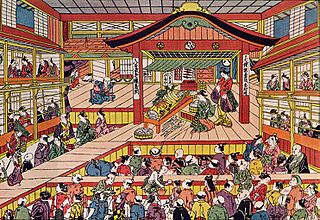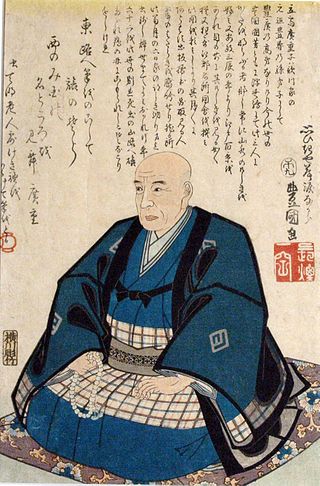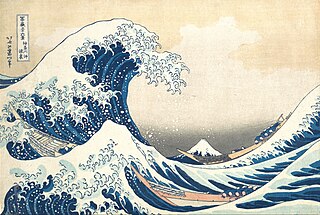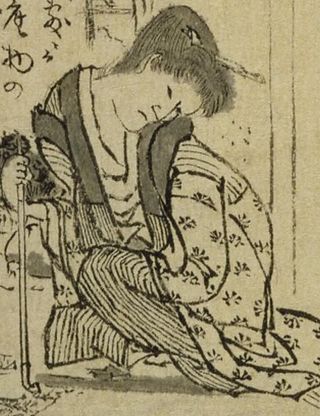
Ukiyo-e is a genre of Japanese art that flourished from the 17th through 19th centuries. Its artists produced woodblock prints and paintings of such subjects as female beauties; kabuki actors and sumo wrestlers; scenes from history and folk tales; travel scenes and landscapes; flora and fauna; and erotica. The term ukiyo-e translates as 'picture[s] of the floating world'.

Katsushika Hokusai, known simply as Hokusai, was a Japanese ukiyo-e artist of the Edo period, active as a painter and printmaker. He is best known for the woodblock print series Thirty-Six Views of Mount Fuji, which includes the iconic print The Great Wave off Kanagawa. Hokusai was instrumental in developing ukiyo-e from a style of portraiture largely focused on courtesans and actors into a much broader style of art that focused on landscapes, plants, and animals. His works are thought to have had a significant influence on Vincent van Gogh and Claude Monet during the wave of Japonisme that spread across Europe in the late 19th century.

Utagawa Kuniyoshi was one of the last great masters of the Japanese ukiyo-e style of woodblock prints and painting. He was a member of the Utagawa school.
Fugaku is another name for Mount Fuji.

Utagawa Hiroshige, born Andō Tokutarō, was a Japanese ukiyo-e artist, considered the last great master of that tradition.

Thirty-six Views of Mount Fuji is the title of two series of woodblock prints by Japanese ukiyo-e artist Hiroshige, depicting Mount Fuji in differing seasons and weather conditions from a variety of different places and distances. The 1852 series, published by Sanoya Kihei, are in landscape orientation using the chūban format, while the 1858 series are in the portrait ōban format and were published by Tsutaya Kichizō. The same subject had previously been dealt with by Hokusai in two of his own series, Thirty-six Views of Mount Fuji, produced from c. 1830 to 1832, and One Hundred Views of Mount Fuji, published in three volumes from 1834 to 1849.
Thirty-six Views of Mount Fuji is a series of woodblock prints by Hokusai.

Thirty-six Views of Mount Fuji is a series of landscape prints by the Japanese ukiyo-e artist Hokusai (1760–1849). The series depicts Mount Fuji from different locations and in various seasons and weather conditions. The immediate success of the publication led to another ten prints being added to the series.

The Great Wave off Kanagawa is a woodblock print by Japanese ukiyo-e artist Hokusai, created in late 1831 during the Edo period of Japanese history. The print depicts three boats moving through a storm-tossed sea, with a large, cresting wave forming a spiral in the centre and Mount Fuji visible in the background.
Ogata Gekkō was a Japanese artist best known as a painter and a designer of ukiyo-e woodblock prints. He was self-taught in art, and won numerous national and international prizes and was one of the earliest Japanese artists to win an international audience.

The term aizuri-e usually refers to Japanese woodblock prints that are printed entirely or predominantly in blue. When a second color is used, it is usually red. Even if only a single type of blue ink was used, variations in lightness and darkness (value) could be achieved by superimposing multiple printings of parts of the design or by the application of a gradation of ink to the wooden printing block (bokashi).

Fine Wind, Clear Morning, also known as Red Fuji, is a woodblock print by Japanese artist Hokusai (1760–1849), part of his Thirty-six Views of Mount Fuji series, dating from c. 1830 to 1832. The work has been described as "one of the simplest and at the same time one of the most outstanding of all Japanese prints".

Eijūdō Hibino at Seventy-one is an ukiyo-e woodblock print dating to around 1799 by Edo period artist Utagawa Toyokuni I. According to its inscription, the print was produced in commemoration of the featured subject, print publisher Nishimuraya Yohachi I's, seventy-first year. The print is part of the permanent collection of the Royal Ontario Museum, Toronto, Canada.

Katsushika Ōi, also known as Ei (栄) or Ei-jo, was a Japanese Ukiyo-e artist of the early 19th century Edo period. She was a daughter of Hokusai from his second wife. Ōi was an accomplished painter who also worked as a production assistant to her father.

Totoya Hokkei was a Japanese artist best known for his prints in the ukiyo-e style. Hokkei was one of Hokusai's first and best-known students and worked in a variety of styles and genres and produced a large body of work in prints, book illustrations, and paintings. His work also appeared under the art names Aoigazono (葵園), Aoigaoka (葵岡) and Kyōsai (拱斎).

Nishimuraya Yohachi was one of the leading publishers of woodblock prints in late 18th-century Japan. He founded the Nishimuraya Yohachi publishing house, also known as Nishiyo (西与), which operated in Nihonbashi's Bakurochō Nichōme under the shop name Eijudō. The firm's exact dates are unclear, but many art historians date its activity to between c. 1751 and 1860.

A View of Mount Fuji Across Lake Suwa is a woodblock print by the Japanese ukiyo-e artist Hokusai.

Kajikazawa in Kai Province is a woodblock print by the Japanese ukiyo-e artist Hokusai.

One Hundred Views of Mount Fuji is a series of three illustrated books by Japanese ukiyo-e artist Hokusai. It is considered one of Japan's most exceptional illustrated books (e-hon), and alongside the Hokusai Manga, the most influential in the West. The first two volumes were published in 1834 and 1835, shortly after completion of his seminal Thirty-six Views of Mount Fuji, with a third released in the late 1840s.

Egawa Tomekichi was a master carver of Japanese woodblock prints in Edo period Japan.














